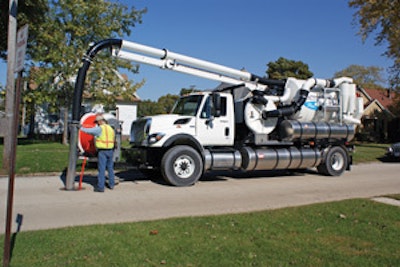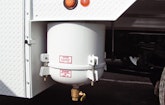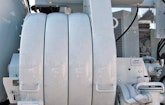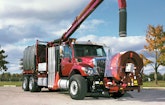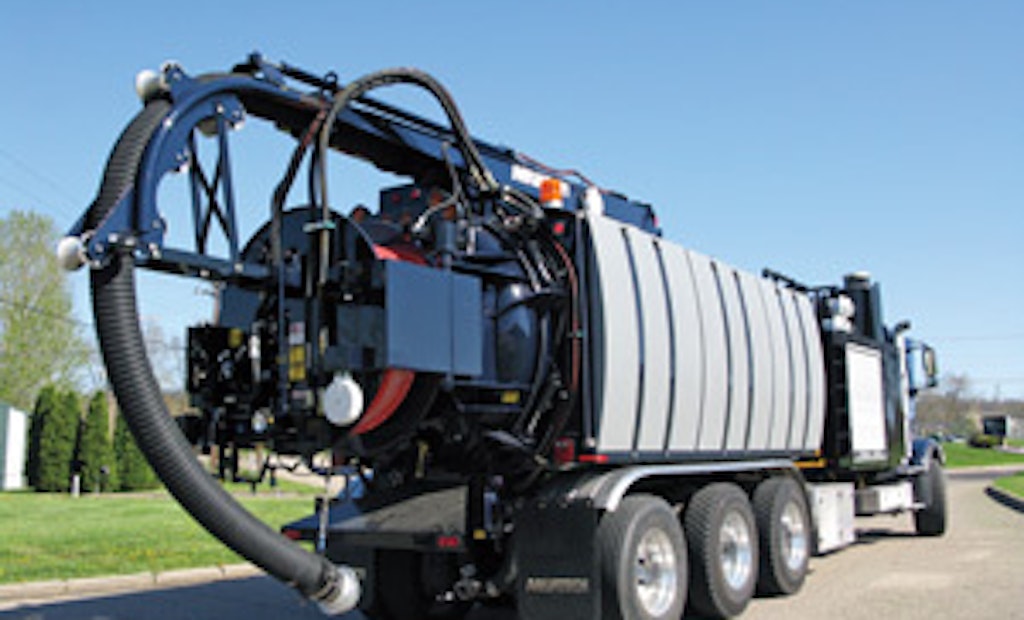Combination sewer cleaning and vacuum trucks are becoming more sophisticated as manufacturers expand their capabilities, improve design and make them safer – all the while attempting to hold the line on prices.
Cleaner asked manufacturers a simple question: “In your view, what is the most important advance in recent years in your company’s combination sewer cleaning trucks as it relates to productivity, reliability or safety – and why?” Their answers are as varied as the broad range of trucks they sell.
Hi-Vac Corporation
“One of the main advantages of the combination units we build today is that they can be used for multiple purposes,” says Pat Snyder, vice president of sales and marketing. “A unit can be used for cleaning pipe, straight jetting, and vacuuming debris from a manhole or catch basin. It can also be used as a hydroexcavator, benefiting a lot of municipalities.”
The company points to its rear hose reel design as safety innovation. “You eliminate the noise problem from the engine and the effect that has on the operator,” says Snyder. “It allows operators to communicate with co-workers and to be more in sync with what’s going on in the work environment. The driver also has a better view with the rear hose, because the front hose reels usually hang at the front right of the truck and decrease the sight line.”
Hi-Vac has also worked to design its vehicles to take advantage of user-serviceable parts. “That’s a deliberate choice on our part to improve reliability and make maintenance easier,” says Snyder. “If the end users need parts for a triplex water pump, they’d probably want to do the repairs themselves, rather than have to source proprietary components. We won’t create a mandate to go back to the manufacturer for repairs.”
Keith Huber Inc.
For Suzanne Huber, president and CEO, the biggest change in combination units is all about the pumps. “We haven’t changed a whole lot of things about our combination units, except in the area of the pumps,” she says. “We have changed the moisture traps and upgraded them to high efficiency to improve the protection of the vacuum pump and to increase its serviceability.”
Huber says the high-pressure water pump on the combination units has also been upgraded. “It wasn’t a service issue,” she notes. “The original pump manufacturer had discontinued the pump we were using, so when we sourced a new pump, we decided to switch to the currently available unit we thought would do the best job.”
Sewer Equipment Co. of America
“The biggest thing we have done in our combo trucks is to create a sewer cleaning nozzle that has the additional capability of being a TV system,” says John Wichmann, vice president of operations. “Previously, you just stuck a nozzle down the line and if it didn’t go somewhere, you had to dig the line out. Video inspection gave operators the ability to better diagnose the lines, but often the sewer truck was waiting a day or a week for the TV truck to come along.”
The company’s Umbilical Cord, launched in 2002, is comprised of a single cord that houses both a sewer hose and a television cable. The camera, located on the jet propulsion skid, uses high-pressure water to propel itself, televising the pipe in full color as it travels from manhole to manhole.
“These are self-leveling color cameras that provide a live feed and also save the image to a digital capture device, so you can update your database,” says Wichmann. “From a safety standpoint, nobody needs to crawl down a manhole to figure out what’s going on. From a productivity standard, two jobs are accomplished at the same time with one machine, and one job site procedure.”
Super Products LLC
“We’re designing the units more toward the contractor market, and that means building more robust machinery, as with our Camel truck line,” says Dan Koziczkowski, product manager, sales. “The municipalities don’t run a combination truck as hard as a contractor might.”
He says the company has always strived to use high-quality components on its vehicles and to source the best components. “We’re just more focused on that right now,” he says. “The point is to do it while maintaining a stable price. We’ve found ways to improve pretty much all the materials used in the combination trucks, but we’ve also found ways to improve some of the major components, such as water pumps, vacuum pumps and pump drive systems.”
Koziczkowski says it’s a challenge to make those improvements while expanding the range of capabilities for the trucks. “It’s not only a sewer and catch basin cleaner – it’s now doing extra duty for hydroexcavating, potholing, trenching, water main repairs and many other applications,” he says. “And it still has to be a tough unit.”
The addition of electronic fail-safe features has made the units safer, he says. “When we design the system so that an operator can’t turn on a water pump or a vacuum pump unless the truck chassis is on idle, it becomes a safer unit.”
VacAll Industries
“The largest advance for the VacAll product line has been the use of Finite Element Analysis to redesign the major weldments that are the backbone of the machines,” says Phil Keller, director of engineering.
“This redesign has reduced weight while increasing structural integrity and payload capacities, resulting in less downtime for unloading waste. During the redesign process, a major focus was placed on designing for robotic welding, which assures a consistent high-quality weld process and a more reliable machine.”
Keller says the company has leveraged its ties with Gradall Industries Inc. to incorporate hydraulic systems and CANbus controls found on that company’s excavators to improve performance, reliability and ease of operation.
“We have the only debris tank in the industry galvanized for corrosion resistance,” says Keller. “Working with engineers at Gradall, a new 85 gpm/2,000 psi water pump has been designed specifically for VacAll. The water tanks are not just standard round shapes. They’re all aluminum and designed specifically for the VacAll to optimize axle weights with the machine loaded or unloaded.”
Keller notes that VacAll combination trucks are now pre-painted before assembly to reduce rust and corrosion while improving appearance. A new powder-coat paint system was added to the company’s manufacturing facility to assure a durable finish.
Vac-Con Inc.
“Perhaps the greatest impact on our product line has been the evolution of the Vac-Con three-stage fan vacuum system,” says Tom Jody, marketing manager. “We introduced the three-stage fan in 1987 with the capability to vacuum underwater.
“This vacuum system became a mainstay for the Vac-Con product line, and with the introduction of hydrostatic drive in 1992, immediately became more versatile and easier to operate. Hydrostatic drive enabled easier operation by eliminating the need for transfer cases, split shafts and belt drives. This feature also allowed the chassis to be operated in neutral, a strong safety consideration.”
The company has recently upgraded the three-stage fan with a fan silencer and a larger 160-cc hydrostatic pump. “These features enable the fan to perform at maximum vacuum levels (200 inches H2O) at much lower rpm for significant fuel savings, as much as 40 percent over previous versions and at lower noise levels – as much as 5 dBA lower – for operator safety and community acceptance,” says Jody.
“So the three-stage fan continues to offer highly productive, short loading times and the ability to vacuum under water without any special attachments, and all with the convenience and safety of hydrostatic drive, but at lower cost through fuel conservation and reduced wear and tear on the chassis.”
Vactor Manufacturing
“As we developed the Vactor 2100 Plus combination truck, we made dozens of improvements that address user-driven priorities, including increasing the cfm rating at the hose inlet, increasing fuel efficiency by up to 34 percent, and making high-dump and variable-flow control standard features,” says Kevin O’Brien, director of marketing with the Federal Signal Environmental Solutions Group.
One feature that stands out for the manufacturer is the Intelliview electronic system, which allows operators to monitor key measures, such as blower temperature, flow, pressure and system diagnostics.
“Intelliview keeps the machine running at peak productivity, saves time and money and helps keep operators safe,” says O’Brien. “It displays readings such as system pressures in real time and also allows the operator to log in settings such as water flow and hose footage deployed.
“This can help reduce water use and equipment wear, and that reduces the cost of ownership. Intelliview also has an easy-to-operate troubleshooting system that accurately diagnoses fault codes. It also validates proper sequencing of functions to prevent misuse of the equipment, and it enables the electronic modules to perform self-diagnostics to ensure that all safety interlocks are satisfied before a function can be completed.”
